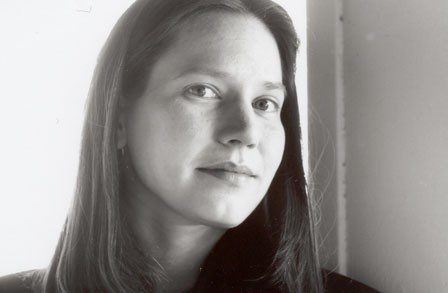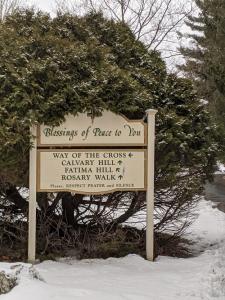I first heard Mary Szybist’s poems about 13 years ago in a St. Louis reading series. The illustrious restaurant/bar that hosted the series was dimly lit that night, save for strings of small white lights around the picture window to the street. The lighting created a large halo behind the readers—Szybist, a professor at Lewis & Clark College, and her husband, Jerry Harp. Szybist’s poems like “Via Negativa” enthralled me:
Sometimes it’s too hard with words or dark or silence.
Tonight I want a prayer of high-rouged cheekbones
and light: a litany of back-lit figures,
lithe and slim, draped in fabrics soft and wrinkleless and pale
as onion slivers. Figures that won’t stumble or cough …
But the prayer will not ache.
When we enter, its chandeliers and skies
will blush with pleasure. Inside
we will be weightless, and our goodness will not matter
in a prayer so light, so empty it will float.
I was captivated to hear contemporary poems that discussed prayer in complicated terms; up until then, my writing life and spiritual life had been on two separate tracks. I had not yet found the church where the priest read Wislawa Szymborska and Mary Oliver as part of his homilies, nor the writing fellowship with other Catholic writers. To hear a poet discuss faith felt revelatory.
And Szybist was gracious too. After the reading, when she signed my copy of her first book, Granted (2003), I asked her where I might find one of the newer poems she’d read. She handed me her own copy—and asked if I was a writer too. Even though I had an MFA, I didn’t feel like a poet yet. However, Szybist wasn’t listening for accolades to decide if I was worth a further conversation. She was encouraging and kind.
Since then, I’ve followed her work avidly, thrilled to finally read her second book, Incarnadine (2013), not surprised when it won the National Book Award, jealous of the University of Cincinnati students who got to take her visiting poet’s workshop after I’d already graduated.
That award winner Incarnadine circles back again and again to the name Mary; if you’re a poet who travels to Italy and sees your namesake in the paintings there, if you grow up—as Szybist has discussed in interviews—looking at the scene of the Annunciation in “real Tiffany windows . . . that changed continually, with the light,” to write about various annunciations is a natural turn.
In Szybist’s hands, such poems take many forms: a diagrammed sentence, prose poems, an erasure, a concrete poem in the shape of the sun. The angle of perspective changes constantly too: We get the point of view of the grass beneath Mary’s knees as Gabriel visits her, for example, and another annunciation poem uses language taken from Nabakov’s Lolita and Kenneth Starr’s report on Bill Clinton’s indiscretions. In another poem, one of my favorites and an abecedarian, two girls put together a puzzle of the annunciation: “Are you sure this blue is the same as the / blue over there? … / Where does this gold / go? It’s like the angel’s giving / her a little piece of honeycomb to eat.” Szybist captures well how a child might look at such a picture—or how we might look past the miracle to the moment itself.
In approaches like this, Szybist is the perfect poet to speak to what we call “sick pilgrims.” She’s spoken of her mixed emotions about faith, saying that faith “is a struggle” to The Oregonian and describing it as complicated to the Portland Monthly:
“W. H. Auden once said that ‘poetry might be described as the clear expression of mixed feelings,’ and my mixed feelings about faith and spirituality often drive my work.”
Yet her childhood growing up in a Catholic Church keeps turning her back to its iconography—and to the spiritual as method, if not foundation: in an interview for the National Book Award site, Szybist said, “I am seeking to extend some of the traditions of devotional poetry to more secular mediations.”
Even with Mary, she’s showing us someone other than the untouchable, highly extolled virgin. In an interview with the Paris Review, Szybist said, “‘Mary’ always seemed so common and overworn, so weighed down by the ‘known’—and by what I came to think of as a Platonic ideal of the Virgin Mary.” Her Marys are sometimes taken over by everyday concerns, as in “Update on Mary”: “Mary always thinks that as soon as she gets a few more things done and finishes the dishes, she will open herself to God. / … Mary wonders if she would be a better person if she did not buy so many almond cookies and pink macaroons.” Don’t we all.
But, as with the best of poems, as with much of the art we sick pilgrims are drawn to, there’s something deeper here: “Mary tells herself that if only she could have a child she could carry around like an extra lung, the emptiness inside her would stop gnawing.” Like this one, the poems in Incarnadine also contemplate procreation and lack thereof, mothers who are ill, mothers who throw their children off of bridges—in all, the places in which “annunciation” does not happen.
That’s the challenge of our faith: when we don’t get the angelic visitation, when there’s no baby or no healing of illness, what happens next? More than a decade after I heard Szybist’s work, I’m still figuring out answers to that question, still like that woman in her early twenties looking for an integrated life—for writing, friendships, and a rich and complex faith all to speak to each other. Poets like Mary Szybist keep me going. I can’t wait to hear what she’s going to say at the Trying to Say God conference in June.
Lisa Ampleman is the author of Full Cry (National Federation of State Poetry Societies Press, 2013) and the chapbook I’ve Been Collecting This to Tell You (Kent State University Press, 2012). She, Mary Szybist and Jerry Harp will all be presenting at Trying to Say God, June 22-24 at the University of Notre Dame.













